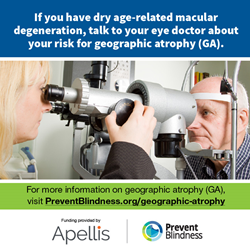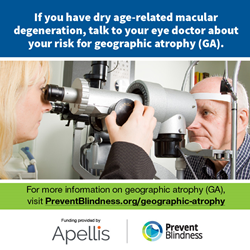
Prevent Blindness declares Dec. 5-11, 2022, as the second annual Geographic Atrophy Awareness Week, providing free educational resources to the public.
“New research and treatment options are promising for geographic atrophy,” said Jeff Todd, president and CEO of Prevent Blindness. “We encourage patients to work closely with their eye doctors to lessen the damaging effects of GA and preserve their vision for the future.”
CHICAGO (PRWEB)
November 30, 2022
Prevent Blindness, the nation’s leading nonprofit eye health organization, is announcing the second annual Geographic Atrophy (GA) Awareness Week as Dec. 5-11, 2022. GA is an advanced form of dry age-related macular degeneration (AMD) which affects central vision. GA can lead to progressive and permanent vision loss.
According to a new study “The Prevalence of Age-Related Macular Degeneration in the United States In 2019” published in JAMA Ophthalmology, an estimated 19.83 million Americans were living with AMD in 2019. Of those, 18.34 million Americans had early AMD and 1.49 million had late-stage vision-threatening forms of AMD (“late-stage AMD” included choroidal neovascularization and geographic atrophy).
To help educate the public on GA, Prevent Blindness has created a variety of resources in English and Spanish, including a downloadable fact sheet and a series of shareable social media graphics. Prevent Blindness also provides a dedicated webpage. Prevent Blindness developed the content of these resources with funding provided by Apellis Pharmaceuticals, Inc.
A new episode of the Prevent Blindness Focus on Eye Health Expert Series, “Geographic Atrophy and Patient Support,” is now available, featuring Prevent Blindness, Ohio Affiliate Past President and CEO, Sherry Williams, who offers her unique perspective of working to advance vision and eye health services as a professional, as well as sharing her personal story of helping to provide ongoing support to her mother, who has GA.
Prevent Blindness offers an additional episode on GA from the Focus on Eye Health Expert Series, where Jeff Todd, president, and CEO of Prevent Blindness, interviews Dr. Janet S. Sunness, medical director of the Richard E. Hoover Low Vision Rehabilitation Services at the Greater Baltimore Medical Center. Dr. Sunness directed a National Institutes of Health-funded natural history study of geographic atrophy. Her research has focused on using visual function measures to better understand retinal disease, particularly AMD and Stargardt disease.
Patients with GA in one eye are more likely to develop it in the other eye. Additional risk factors for developing GA include:
-
Family history of AMD - Age – over 60 years old
- Race – Caucasians have a higher rate of AMD
- Light-colored eyes
- Smoking
- Genetics
- Heart disease
- Diabetes
- Women not using menopausal hormone replacement therapy
- High blood pressure (hypertension)
- High cholesterol
- Obesity
- High sun exposure throughout the lifespan
- Poor diet with a low intake of fruits and vegetables (specifically dark green leafy vegetables)
For GA patients and their care partners, Prevent Blindness recently launched its updated online resource Living Well with Low Vision. This free program provides a variety of free directories, a library of self-help guides, downloadable apps including the GuideME for AMD, access to clinical trial research, and recent news highlighting AMD research and lifestyle articles.
“New research and treatment options are promising for geographic atrophy,” said Mr. Todd. “We encourage patients to work closely with their eye doctors to lessen the damaging effects of GA and preserve their vision for the future.”
For more information on geographic atrophy, please visit https://preventblindness.org/geographic-atrophy. For a listing of vision care financial assistance programs in English or Spanish, visit https://www.preventblindness.org/vision-care-financial-assistance-information.
About Prevent Blindness
Founded in 1908, Prevent Blindness is the nation’s leading volunteer eye health and safety organization dedicated to fighting blindness and saving sight. Focused on promoting a continuum of vision care, Prevent Blindness touches the lives of millions of people each year through public and professional education, advocacy, certified vision screening and training, community and patient service programs, and research. These services are made possible through the generous support of the American public. Together with a network of affiliates, Prevent Blindness is committed to eliminating preventable blindness in America. For more information, visit us at preventblindness.org, and follow us on Facebook, Twitter, Instagram, LinkedIn, and YouTube.
###
Share article on social media or email:

